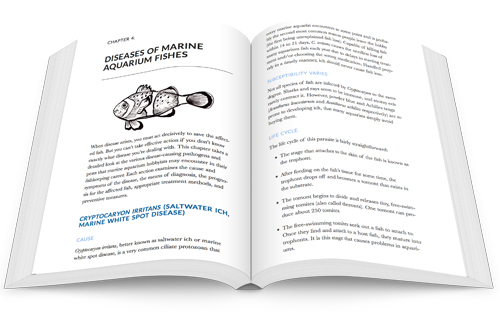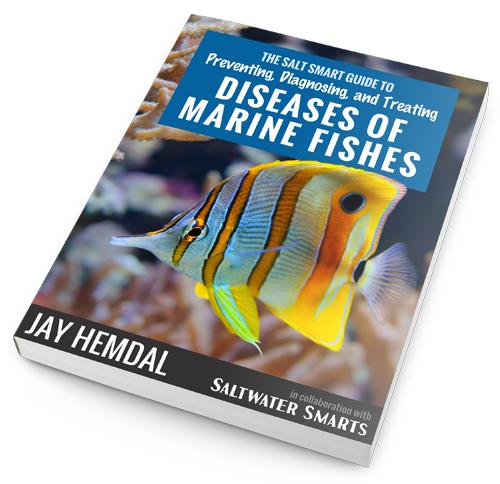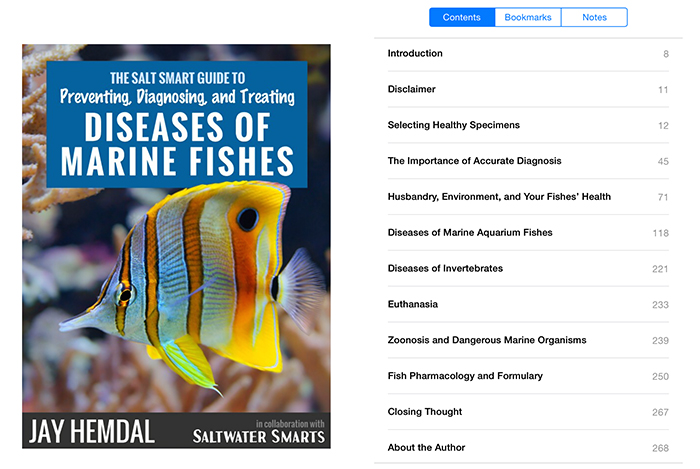By Randy Donowitz
Visit any aquarium on-line forum any day of the week and without fail there will be at least one new post about sick or dying fish. All pet owners are obligated to be the guardians of their animal’s health and well being, but in nearly all areas of home pet care, there are professional veterinarians readily available to help. Beyond the obvious cat and dog care, it is not uncommon to find care for birds, reptiles and other small animals and hobbyist level keepers commonly avail themselves of these services. While aquatic vets certainly exist, they are not common and it is extremely rare that hobbyists have access to them. Instead, we rely on amateur diagnosis, research, and treatment, and the collective hobbyist wisdom born from years of experience and practice.
Consequently, access to accurate and easily replicable, scientifically based information is critical to hobbyists if they have any chance of effectively dealing with the host of maladies that beset marine fishes in captivity. On-line forums can be great resources, but there is as much bad information tossed around as there is good. There are quality chapters on the subject in many hobbyist books, and even a few books dedicated to diseases in fish, but how many people actually make the effort to buy and read such specialized books?
The brain-trust at Saltwater Smarts had the good sense to realize this glaring need of marine hobbyists and teamed up with noted author and professional aquarist from the Toledo Zoo, Jay Hemdal to produce an authoritative, yet accessible e-book dedicated to the comprehensive prevention, identification and treatment of marine fish diseases. For a very modest $14.99 anyone can download a copy of The Salt Smart Guide to Diseases of Marine Fishes in EPUB, MOBI, and PDF formats for viewing anywhere on virtually any device.
 Hemdal speaks with the knowledgeable voice of a professional from a public aquarium where disease control takes on a scale and level of import far beyond those of the home hobbyist. The book presents an exhaustive range of procedures, options and alternatives -many well beyond the practical means of the home aquarist. Still, these “extremes” are valuable because they show what it really takes to properly diagnose, and treat diseases and highlights how short common hobby practices often fall. The bulk of the information, however, is practical and written in a down to earth style that will maximize benefit to hobbyists of all levels.
Hemdal speaks with the knowledgeable voice of a professional from a public aquarium where disease control takes on a scale and level of import far beyond those of the home hobbyist. The book presents an exhaustive range of procedures, options and alternatives -many well beyond the practical means of the home aquarist. Still, these “extremes” are valuable because they show what it really takes to properly diagnose, and treat diseases and highlights how short common hobby practices often fall. The bulk of the information, however, is practical and written in a down to earth style that will maximize benefit to hobbyists of all levels.
The book is divided into eight well-organized chapters effectively augmented by photographs, illustrations and charts that talk the reader through issues of healthy fish selection, acclimation, husbandry, and quarantine. The latter is a subject of great importance to hobbyists and one that is often surrounded by apprehension and confusion. Hemdal does an excellent job of highlighting the importance of quarantine before he lays out in detail the processes and procedures of successful QT:
All new fish must be assumed to be harboring disease, regardless of their history. Freshly captured wild fish, fish from pet shops, as well as locally tank-raised fish can potentially transmit infections to a stable aquarium population (aside from causing mortality in the new fish themselves).
To help control these problems, all new fish should undergo a quarantine procedure prior to their introduction into an aquarium housing other fish. These quarantine protocols often represent a compromise between their degree of effectiveness, the level of effort required, and the safety of the animals themselves.
At one end of the spectrum is using no quarantine procedure at all, which is the easiest course of action but obviously the least effective. At the other end is a very comprehensive quarantine protocol that can require months to perform and utilizes a wide variety of medications along with veterinary services to determine that the fish are free of all disease. A middle-ground approach is best for the home aquarist. Using simple visual symptoms from the fish combined with uncomplicated but effective prophylactic treatments, new fish can be more safely added to an established aquarium. (Hemdal pg. 23- 24)
The majority of the book is concerned with environmental and husbandry issues that affect fish health and the plethora of specific diseases that afflict marine fish. Cause, symptoms, diagnosis, and treatment are addressed for each disease. If you read these chapters carefully, many of the “mystery” deaths so commonly referenced in the hobby become a lot less mysterious.
Hemdal also pays attention to issues like euthnasia, human dangers from marine organism disease, and curiously, a chapter on diseases of invertebrates (this is a book on fish disease after all). The volume closes with a very useful fish pharmacology and formulary that will greatly aid the home aquarist in proper preparation, dose calculation and administration of medications.
This is an impressive work that should be required reading for all marine aquarium keepers. As Hemdal implores us in his closing thought:
With a little effort and some guidance on how to direct that effort, you can increase the survivability of the fish in your marine aquarium by a huge factor. This, in turn, means you’ll buy fewer replacement fish, saving you money and making the hobby itself more environmentally sustainable.
The information contained in this book is a compilation of my 45-plus years of experience working in public aquariums and the pet industry and keeping home aquariums. I truly want to see every marine aquarist achieve success, but the information provided here is only a start; you must then take the initiative to apply it—and even look for ways to improve upon it.

The Salt Smart Guide to Diseases of Marine Fishes can be purchased at the Salt Water Smarts website or directly through Gumroad. and I strongly encourage all hobbyists to do so.




Great to read this article.